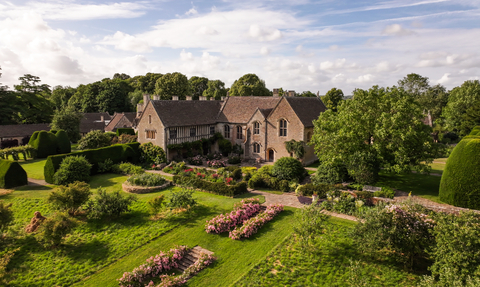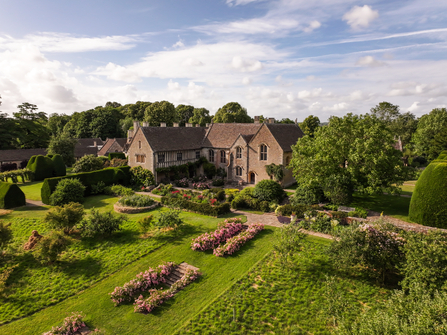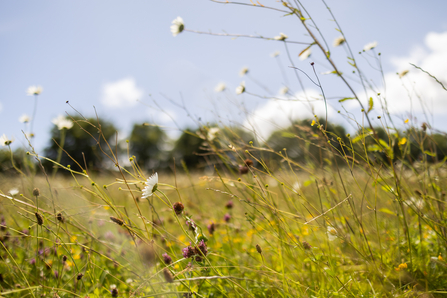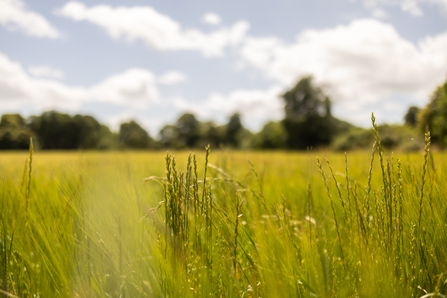
Credit: James Beck
Transforming Great Chalfield
The National Trust and Wiltshire Wildlife Trust have formed a groundbreaking partnership to transform the farm at Great Chalfield Manor in Wiltshire into a thriving hub for nature’s recovery and regenerative farming.
This collaboration marks a new chapter for the historic estate, which has been in the care of the National Trust since 1943, when the manor and part of the estate was gifted to the heritage and conservation charity, with around 20,000 people visiting the medieval manor and garden each year.

Credit: James Beck
In total 140 hectares of arable, pasture and farmland at Great Chalfield will be managed in partnership between the two charities, including a collaboration with the Great Western Community Forest who are supporting the acquisition of the land and the planting of c11,000 trees. WWT have committed to a 49-year lease that will enable the charity to manage the land for natures recovery, a principle that aligns with the National Trust plans for land and nature.

Credit: James Beck
The aim for the land is to develop a learning hub where farmers and landholders can learn how to develop a range of nature-based solutions. This will include the creation of species-rich grassland and hedgerows, wood pasture and ponds to tackle the nature and climate crisis and access new markets for environmental services as part of a regenerative farming system that prioritises soil health.

Credit: James Beck
This collaboration holds special significance for the Wiltshire Wildlife Trust, as it brings them back to the roots of their organisation. Great Chalfield Farm is the family home of the Trust Patron, whose father played a pivotal role as one of the Trust's founding members.
The organisations are optimistic about the project's potential. The National Trust sees it as a powerful demonstration of how partnerships can deliver for both people and nature, creating more space for wildlife to thrive and addressing the pressing challenges of climate change. Wiltshire Wildlife Trust views it as a unique opportunity to showcase how nature-based solutions can be seamlessly integrated into a profitable and regenerative farming system. This exciting partnership between the National Trust and Wiltshire Wildlife Trust sets a promising precedent for sustainable land management, proving that it's possible to balance the needs of nature, climate, and food production while creating a thriving and resilient landscape for future generations.
The first steps will involve a comprehensive assessment of the land to gather baseline data and understand its history, biodiversity, and agricultural value.
Frequently Asked Questions
What is the connection?
Major R.F Fuller gave Great Chalfield Manor, Garden and part of the estate to the NT in 1943. It has been home to the family for generations, including one of WWT’s founder Chairman, Charles Floyd FLS (Fellow Linnean Society), father of current family tenant Robert Floyd. Robert has also been the Chair of WWT in the past and is our current Patron. This partnership is not only positive for the future of Great Chalfield it also celebrates the connection between the two charities through the Floyd family. In partnership we will demonstrate farming with nature in the future and explain that story in relation to Great Chalfield, the wider landscapes and county of Wiltshire.
How can I get involved?
The Wiltshire Wildlife Trust actively welcomes volunteers to participate in various projects. Volunteering opportunities are currently limited whilst the project is in early scoping stage, but you are welcome to register your interest to be notified of any upcoming opportunities. You can register here to find out more and sign up. If you don’t want to volunteer but still want to contribute you can donate here or become a member here . Vital funds from our donors and members help us deliver crucial projects to protect nature just like this one.
What is the vision for Great Chalfield Farm?
The vision is to create a model of regenerative farming that balances the needs of nature's recovery, climate resilience, and food production. It aims to demonstrate how sustainable practices can be profitable and beneficial for both the environment and the local community. It will provide farmers and landowners with the knowledge of how to access and manage successful green finance initiatives.
What will the land be used for?
The mixed farm has been used for arable production as well as livestock grazing and the ambition of WWT is to create a demonstration site for farmers and landholders to learn how to develop a range of nature-based solutions and access new markets for environmental services, integrated alongside agriculture. WWT will develop the land in support of Wiltshire’s emerging Local Nature Recovery Strategy and the new Local Nature Partnership for Wiltshire, engaging visitors with the vision of ’30% of land well-managed for nature by 2030’ and the role of regenerative farming in nature’s recovery and net zero. We will also be planting roughly 11,000 trees under the Trees for Climate programme, including examples of agroforestry, wood pasture and deciduous woodland.
How does this benefit the public?
The partnership will provide much-needed ‘green infrastructure’ for the expanding communities of Melksham and Trowbridge – with existing footpaths around the site – and raise awareness of how people can take meaningful action for nature. This will sit alongside the Great Chalfield Manor and Garden visitor experience led by the NT.
Why are you encouraging farming?
The work of WWT is diverse, and working alongside the farming community is essential to nature’s recovery in Wiltshire. The Consensus on Food, Farming and Nature, to which The Wildlife Trusts and the National Trust are signatories, builds on a robust evidence base that demonstrates we can achieve our Nature Recovery, Net Zero and Food Security goals through a regenerative farming and land use transition. To achieve this vision, farmers and land managers need support to find a resilient and profitable pathway to more nature-friendly farming and agroforestry. New income streams from environmental services markets have an important role to play, alongside public money from the emerging Environmental Land Management Scheme; cost savings from reduced input reliance; access to new markets, including for tree products; and diversification for eco-tourism.
How does this help farmers?
In time we plan to establish a Farming and Nature Learning Hub which will give farmers and land managers an opportunity to see and understand the nature-based projects that can contribute to their farm business model and learn about how to take a data-led approach to evidencing and marketing their impact. Farmers learn best from other farmers, and we will make the Learning Hub widely available as a resource for farmer clusters.
What does this mean for nature?
Great Chalfield is situated in a priority area for nature’s recovery, both for Wiltshire and the Bristol Avon Catchment. It has excellent connectivity to the wider nature recovery network via ancient hedgerows and the Lenton and Chalfield Brooks. It has strong potential for:
- Increasing populations of many of Wiltshire’s critical species, notably 9 species of bats, including rare Greater Horseshoe Bats, helping to mitigate the impact of Trowbridge’s urban expansion.
- A whole farm tree plan, integrating agroforestry and extending hedgerows and farm woodland alongside existing hedgerows and specimen trees.
- Green infrastructure in a part of Wiltshire earmarked for significant urban extension in the Local Plan.
Will the public still be able to visit Great Chalfield Manor and its gardens?
Great Chalfield Manor and Garden will continue to open as a National Trust visitor attraction under the stewardship of Robert and Patsy Floyd, supported by the NT operational team at Lacock. The Manor and Garden are not part of the lease to WWT. WWT will take over management of the land surrounding Great Chalfield – the land recently acquired in addition to the land already owned by the National Trust. For more information visit the Great Chalfield webpage.
